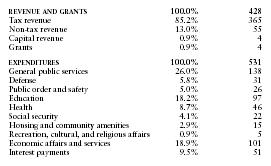Fiji - Public finance
From 1985–96, Fiji suffered a crisis in both private and public investment. Total investment—both public and private—stood at 21.3% of GDP in 1985 and had dropped to 15.8% in 1994. Investment in public enterprises rose for the same period, however, from 3.2% of GDP in 1985 to 6.5% in 1994. The fiscal position of the government also worsened after 1996 due to the collapse of the National Bank of Fiji. During that time, the public deficit increased to 6.5% of GDP, but fell to 2.4% of GDP in 1998.
The US Central Intelligence Agency (CIA) estimates that in 2000 Fiji's central government took in revenues of approximately $427.9 million and had expenditures of $531.4 million. Overall, the government registered a deficit of approximately $103.5 million. External debt totaled $162.7 million.
The following table shows an itemized breakdown of government revenues and expenditures. The percentages were calculated from data reported by the International Monetary Fund. The dollar amounts (millions) are based on the CIA estimates provided above.

| REVENUE AND GRANTS | 100.0% | 428 |
| Tax revenue | 85.2% | 365 |
| Non-tax revenue | 13.0% | 55 |
| Capital revenue | 0.9% | 4 |
| Grants | 0.9% | 4 |
| EXPENDITURES | 100.0% | 531 |
| General public services | 26.0% | 138 |
| Defense | 5.8% | 31 |
| Public order and safety | 5.0% | 26 |
| Education | 18.2% | 97 |
| Health | 8.7% | 46 |
| Social security | 4.1% | 22 |
| Housing and community amenities | 2.9% | 15 |
| Recreation, cultural, and religious affairs | 0.9% | 5 |
| Economic affairs and services | 18.9% | 101 |
| Interest payments | 9.5% | 51 |
Comment about this article, ask questions, or add new information about this topic: